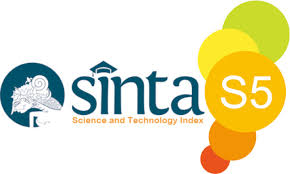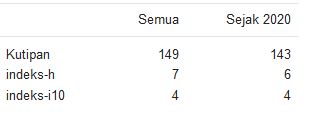The Relationship between Diet and Iron Deficiency Anemia in Post Partum Mothers in Dr. Zainoel Abidin Banda Aceh in 2019
DOI:
https://doi.org/10.46749/8s3dqy13Keywords:
Diet Pattern, Iron Deficiency Anemia, postpartumAbstract
One of the problems that contributed the largest numbers on mortality and maternal morbidity was anemia in the postpartum period. It is estimated that 50-80% of women suffer from anemia at 48 hours after birth. Anemia in women is associated with increased birth Infant Low Birth Weight (LBW), prematurity, maternal and child deaths and infections. This study aims to identify the relationship between dietary patterns and the incidence of iron deficiency anemia in post partum mothers at dr. Zainoel Abidin hospital Banda Aceh. This research is a quantitative study with a cross sectional study design. This research was conducted from June to September 2019 with 102 respondents selected through the non-probability sampling method. Respondents were postpartum mothers who were treated in room 2 (obstetric inpatient room). The study technique was carried out by giving a questionnaire and hemoglobin check has been carried out using HB meter. The data obtained were analyzed using the chi square statistical test with a confidence level of 95%. This study found that the prevalence of anemia was 49,0% of respondents had mild anemia (Hb levels 9-10,9 gr / dl), 10,8% had moderate anemia (Hb levels 7-8,9 gr / dl), and 40,2% not having anemia (Hb levels >11gr / dl). Overall, there is a significant relationship between dietary patterns and the incidence of anemia in postpartum mothers at dr. Zainoel Abidin Banda Aceh (p value 0,032).
References
Achebe MM, Gafter-gvili A. (2017) How I treat anemia in pregnancy: iron, cobalamin, and folate. Blood;129(8):940–9.
Adriani M, Wirjatmadi B (2012). Pengantar Gizi Masyarakat. Jakarta: Kencana.
Almatsier, S. (2010).Prinsip Dasar Ilmu Gizi. Jakarta: PT Gramedia Pustaka Utama.
American Pregnancy Association. (2017) Where To Get Iron Naturally During Pregnancy. American Pregnancy. Available from: https://americanpregnancy.org/naturally/get-iron-naturally-pregnancy/
Carroli G, Cuesta C, Abalos E. (2008). Epidemiology of postpartum haemorrhage : a systematic review. Best Pract Res Clin Obstet Gynaecol. Elsevier Ltd;;22(6):999–1012.
Di Renzo GC, Spano F, Giardina I, Brillo E, Clerici G, Roura LC. (2015). Iron deficiency anemia in pregnancy. Women’s Heal;11(6):891–900.
Garrido CM, León J, Vidal AR, Garrido CM, Le J, Roman A. (2017). Maternal anaemia after delivery : prevalence and risk factors. J Obstet Gynaecol (Lahore). Informa UK Limited, trading as Taylor & Francis Group;0(0):1–5.
Gluckman P, Hanson M, Seng CY, Bardsley A. (2015). Nutrition & Lifestyle for Pregnancy & Breastfeeding. United Kingdom: Oxford University Press.
Ikeanyi EM, Ibrahim AI. (2015). Does antenatal care attendance prevent anemia in pregnancy at term. Ikeanyi E M, Ibrahim A I - Niger J Clin Pract.18(3):323–8.
Ismail B, Sufi R, Joesoef MD, Leumiek HK, Nurdin. (2018). Ensiklopedia Budaya Adat Aceh. Banda Aceh: Majelis Adat Aceh.
Judd SJ. (2010). Blood and circulatory disorders. Ed. 3. Omnigraphics, Inc. United States: Omnigraphics, Inc. 162-165 p.
Kaphle S, Hancock H, Newman LA. (2013) Childbirth traditions and cultural perceptions of safety in nepal: Critical spaces to ensure the survival of mothers and newborns in remote mountain villages. Midwifery . Elsevier;29(10):1173–81. Available from: http://dx.doi.org/10.1016/j.midw.2013.06.002
Kemenkes RI. (2010). Pedoman pelayanan antenatal terpadu. Jakarta: Kementerian Kesehatan Republik Indonesia, Direktur Jenderal Bina Kesehatan Masyarakat; 1-40 p.
Kemenkes RI. (2013) Riset kesehatan dasar 2013. Jakarta: Badan Penelitian dan Pengembangan Kementerian Kesehatan RI.
Milman N. (2011) Postpartum anemia I : definition , prevalence , causes , and consequences. Ann Hematol. 90:1247–53.
Milman N. (2015) Postpartum anemia II : prevention and treatment. Ann Hematol. 91:143–54.
Morsy N, & Alhady S. (2014). Nutritional status and socio-economic conditions influencing prevalence of anaemia in pregnant women. 2014;3(7):54–60.
New S, & Wirth M. (2015). Anaemia, pregnancy, and maternal mortality: The problem with globally standardised haemoglobin cutoffs. BJOG.122(2):166–9.
Puspitawati, Batubara R. (2015). Persalinan Ma’blien pada Masyarakat Desa Sawang Kecamatan Samudera Aceh Utara. J Antropol Sos dan Budaya Pertolongan.1(2):124–32.
Rakesh P, Gopichandran V, Jamkhandi D, Manjunath K, George K, Prasad J. (2014) Determinants of postpartum anemia among women from a rural population in southern India. Int J Womens Health. 395–400.
Rubio-álvarez A, Molina-alarcón M, Hernández-martínez A. (2017). Incidence of postpartum anaemia and risk factors associated with vaginal birth. Women and Birth. Australian College of Midwives;(7).
Silverberg DS. (2012). Anemia. Croatia: InTech. 233-240 p.
Sirajuddin S, Hadji V, Musni. (2014). The Effect of Eggs Consumption and Nutrition Counseling to the Increasing of Body Weight and Hemoglobin of Pregnant Women at Kassi-Kassi Health. Int J Sci Res Publ.4(4):1–9.
Vir SC (2011). Public health nutrition in developing countries. New Delhi: Woodhead Publishing India Pvt. Ltd.
Waryana. (2010). Gizi Reproduksi. Yogyakarta: Rajawali Press.
Downloads
Published
Issue
Section
License
Copyright (c) 2020 Unit Penelitian dan Pengabdian Masyarakat STIKES Fatmawati

This work is licensed under a Creative Commons Attribution-NonCommercial-ShareAlike 4.0 International License.





